Its a Mad, Mad, Mad, Mad World
7.6 /10 1 Votes
75% Rotten Tomatoes Genre Action, Adventure, Comedy Duration Country United States | 7.6/10 IMDb Director Stanley Kramer Screenplay William Rose, Tania Rose Language English | |||||||||||||||||||||||||||||||||
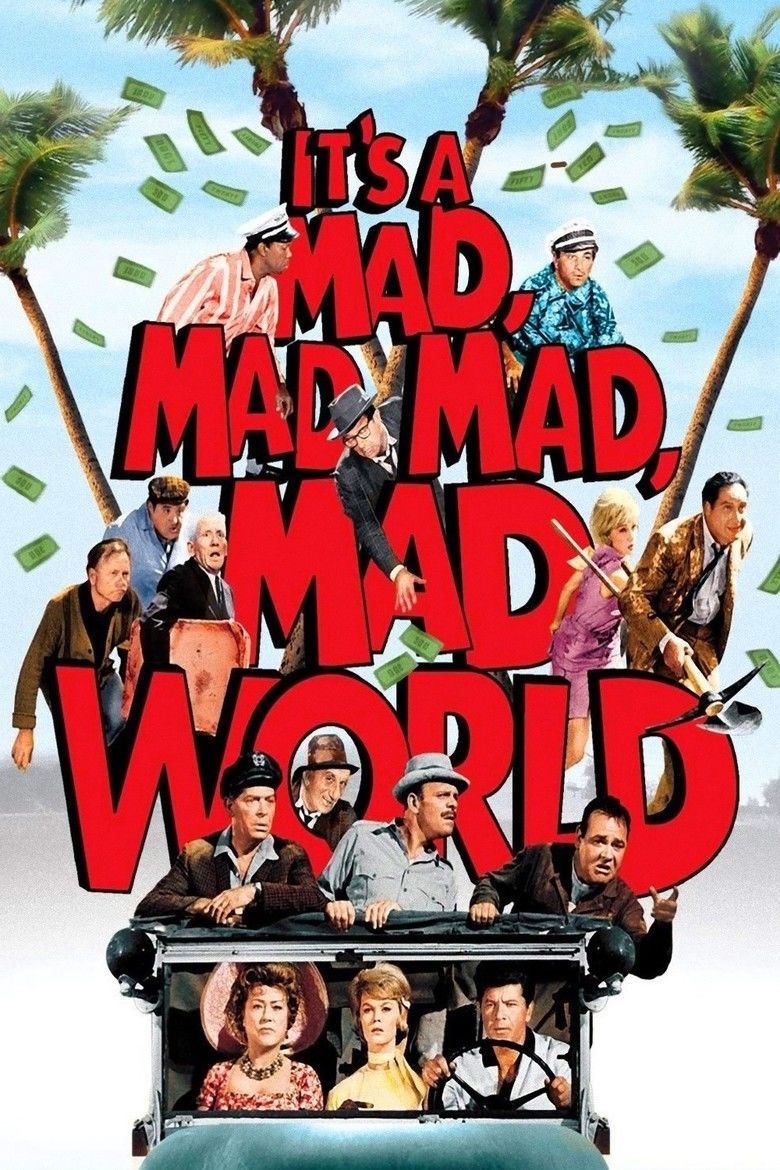 | ||||||||||||||||||||||||||||||||||
Writer William Rose , Tania Rose Release date November 7, 1963 (1963-11-07) Film series Its a Mad, Mad, Mad, Mad World Film Series Cast Spencer Tracy (Capt. C. G. Culpepper), Milton Berle (J. Russell Finch), Sid Caesar (Melville Crump, DDS), Buddy Hackett (Benjy Benjamin), Mickey Rooney (Ding 'Dingy' Bell), Moe Howard (Airport Firemen #1)Similar movies Blackhat , Horrible Bosses 2 , The Italian Job , Son of a Gun , Knight and Day , Straight Outta Compton Tagline The biggest entertainment ever to rock the screen with laughter! | ||||||||||||||||||||||||||||||||||
Don knotts and phil silvers in it s a mad mad mad mad world hd
The story begins during a massive traffic jam, caused by reckless driver Smiler Grogan (Jimmy Durante), who, before kicking the bucket, cryptically tells the assembled drivers that hes buried a fortune in stolen loot, under the Big W. All of the motorists set out to find the fortune.
Contents
- Don knotts and phil silvers in it s a mad mad mad mad world hd
- Plot
- Cameo appearances
- Background
- Production
- Widescreen process
- Animated credit sequence
- Reception
- Awards and honors
- Versions
- Home media
- Influence
- References
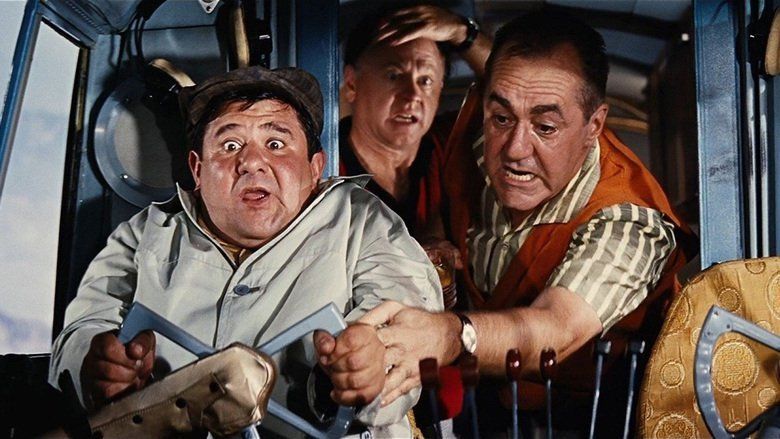
Its a Mad, Mad, Mad, Mad World is a 1963 American epic comedy film produced and directed by Stanley Kramer and starring Spencer Tracy with an all-star cast, about the madcap pursuit of $350,000 in stolen cash by a diverse and colorful group of strangers. The ensemble comedy premiered on November 7, 1963. The cast features Edie Adams, Milton Berle, Sid Caesar, Buddy Hackett, Ethel Merman, Mickey Rooney, Phil Silvers, Terry-Thomas and Jonathan Winters.

The film marked the first time that Kramer had directed a comedy; though he had produced the comedy So This Is New York in 1948, hes best known for producing and directing drama films about social problems (such as The Defiant Ones, Inherit the Wind, and Guess Whos Coming to Dinner). His first attempt at a comedy film paid off immensely, as Its a Mad, Mad, Mad, Mad World became a stunning critical and commercial success in 1963 and went on to win an Academy Award (for Best Sound Editing) and be nominated for five additional Academy Awards and two Golden Globe Awards. Despite this, the film suffered severe cuts by its distributor, United Artists, resulting in a shorter running time for its general release. The footage was excised against Kramers wishes. The lost footage seriously deteriorated through the decades and was once thought impossible to restore.
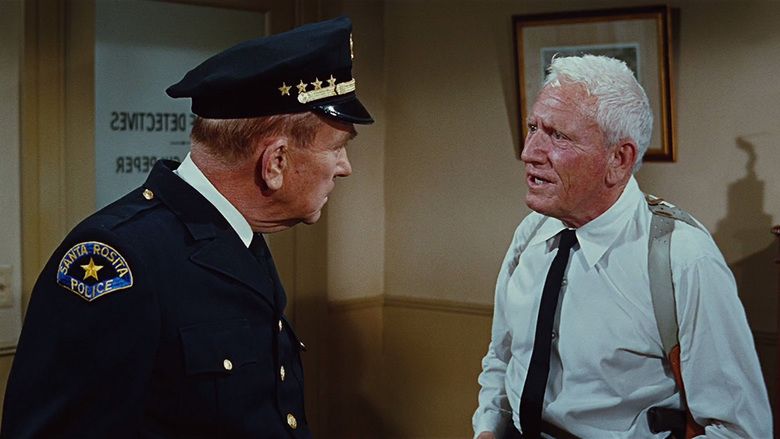
On October 15, 2013, however, it was announced that The Criterion Collection had collaborated with Metro-Goldwyn-Mayer, United Artists, and film restoration expert Robert A. Harris to reconstruct and restore Its a Mad, Mad, Mad, Mad World to as close as possible to the original 197-minute version envisioned by Kramer. It was released in a 5-disc "Dual Format" Blu-ray/DVD Combo Pack on January 21, 2014. Its a Mad, Mad, Mad, Mad World featured at #40 in the American Film Institutes list 100 Years...100 Laughs.
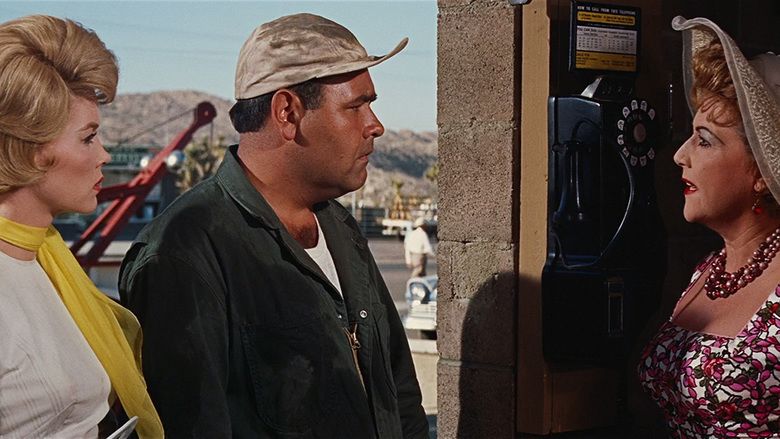
A group of strangers come across a man dying after a car crash who proceeds to tell them about the $350,000 he buried in California. What follows is the madcap adventures of those strangers as each attempts to claim the prize for himself.
Plot

"Smiler" Grogan (Jimmy Durante), wanted by police in a tuna factory robbery fifteen years ago and on the run from the police, careens his 1957 Ford Victoria off twisting, mountainous State Highway 74 near Palm Springs in Southern California and crashes. Five motorists stop to help him - Melville Crump (Sid Caesar), a dentist, Lennie Pike (Jonathan Winters), a furniture mover, Dingy Bell (Mickey Rooney) and Benjy Benjamin (Buddy Hackett), two friends on their way to Las Vegas, and J. Russell Finch (Milton Berle), who owns Pacific Edible Seaweed Company in Fresno. Just before he dies, Grogan tells the five about $350,000 buried in Santa Rosita State Park near the Mexican border under a mysterious "big W".
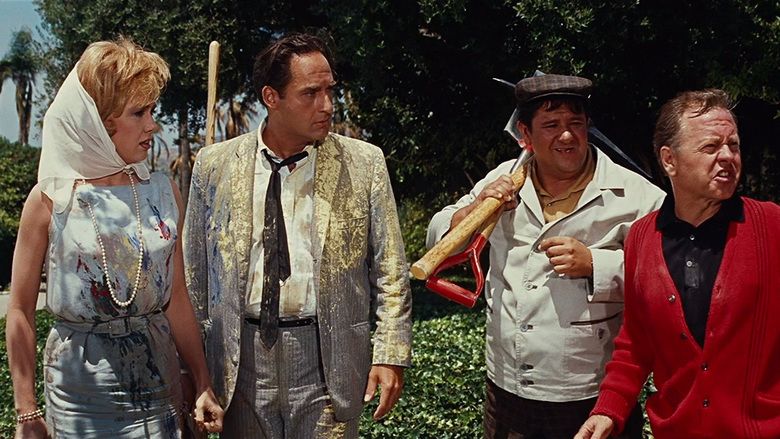
Initially, the motorists try to reason with each other and share the money, but it soon becomes an all out race to get the money first. Unbeknownst to them all, Captain T. G. Culpeper (Spencer Tracy), Chief of Detectives of the Santa Rosita Police Department, has been patiently working on the Smiler Grogan case for years, hoping to someday solve it and retire. When he learns of the fatal crash, he suspects that Grogan may have tipped off the passersby, so he has them tracked by various police units. His suspicions are confirmed by their behavior.
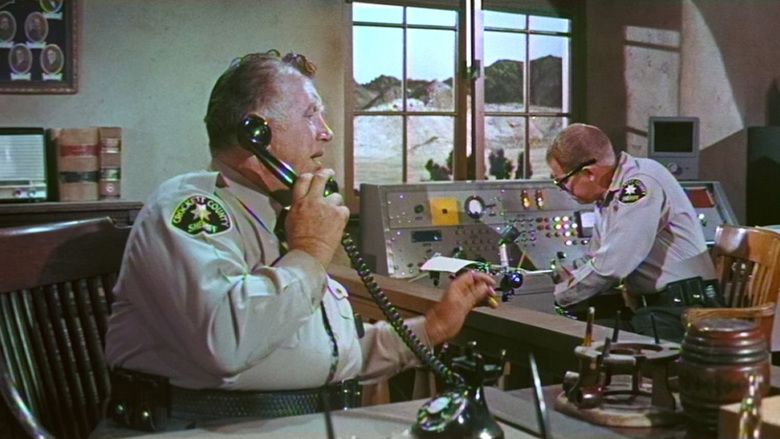
Everyone experiences multiple setbacks on their way to the money. Crump and his wife Monica (Edie Adams) charter an old WWI-era biplane and eventually make it to Santa Rosita, but are soon locked in the basement of a hardware store. They eventually free themselves with dynamite. Bell and Benjamin charter a modern plane, but when their wealthy alcoholic pilot (Jim Backus) knocks himself out drunk, the two are forced to fly and land the plane themselves. Finch, his wife Emmeline (Dorothy Provine), and his loud and obnoxious mother-in-law, Mrs. Marcus (Ethel Merman), are involved in a car accident with Pikes 1954 Ford furniture van. The three flag down United Kingdom Army Officer Lt. Col. J. Algernon Hawthorne (Terry Thomas) in his 1951 Willys station wagon, and convince him to drive them to Santa Rosita. After many arguments, most caused by Mrs. Marcus, she and Emmeline refuse to go any farther, and Finch and Hawthorne leave them by the side of the road in Yucca Valley. Pike tries to get motorist Otto Meyer (Phil Silvers) in his ivory-colored 1948 Ford convertible to take him to Santa Rosita, but he is betrayed, and the greedy Meyer races for the money on his own, leaving Pike stranded with only a little girls bike from his furniture van. A furious Pike later meets up with Meyer, determined to beat him up. Infuriated by Meyer, Pike literally destroys a gas station owned by brothers, Ray and Irwin (Arnold Stang and Marvin Kaplan), singlehandedly.
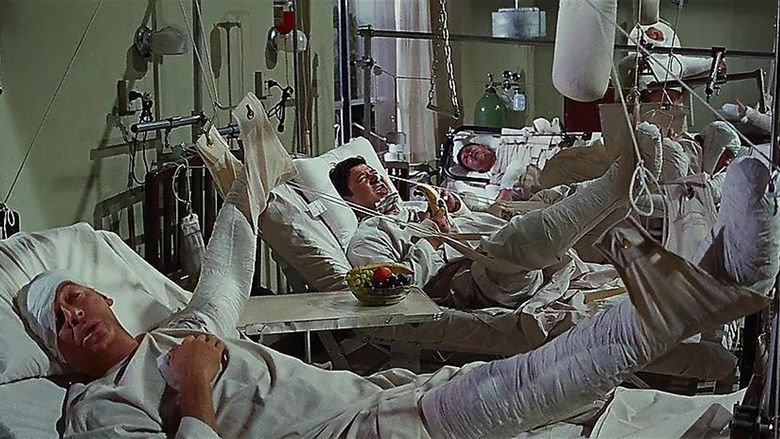
Pike steals Ray and Irwins 1946 Dodge Power Wagon tow truck and meets up with Mrs. Marcus and Emmeline and picks them up. While in a town called Plaster City, Mrs. Marcus calls her son Sylvester (Dick Shawn), who lives on Silver Strand Beach near Santa Rosita, to get the money for them, but misunderstanding and believing his mother is in trouble, he instead races to her in his red 1962 Dodge Dart convertible. Meyer experiences his own setbacks, including sinking his car while trying to cross the Kern River and nearly drowns. He manages to steal a blue 1956 Ford Sunliner belonging to a passing motorist (Don Knotts) by telling him hes with the CIA and re-joins the hunt. All the while Culpeper and the police department observe their activities from afar. Around this time two taxi drivers (Peter Falk and Eddie "Rochester" Anderson) get in on the chase in their 1959 Plymouth Yellow Cabs.
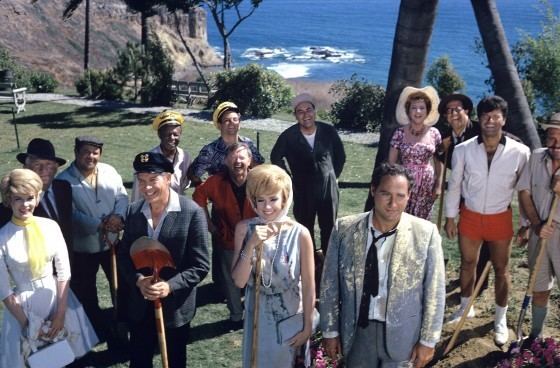
Eventually all the characters meet up at Santa Rosita State Park and search for the big W. It is Emmeline, who wants no part of the money, who first finds the W, composed of four palm trees growing in the shape of a W. Pike finds it next and informs everyone else. Culpeper orders all policemen to leave the area, and goes in solo to retrieve the money. However, he actually plans to take the money to Mexico to escape a dysfunctional family and a job with a very small pension. After everyone digs up the money, Culpeper orders them to turn themselves in, promising a jury will be more lenient. But when the group sees Culpeper leaving with the money, they follow him in the two 1959 Plymouth cabs. At that point, Chief Aloysius (William Demarest) orders Culpepers arrest, after his blackmailing of the mayor to treble Culpepers pension.
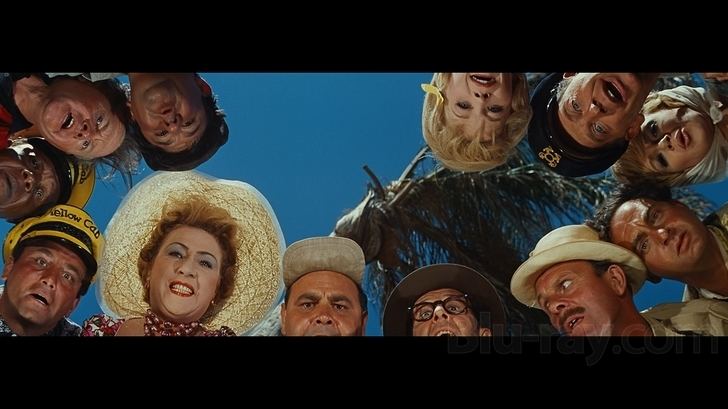
After a long chase sequence, everyone ends up stranded on the fire escape of an abandoned office building in Long Beach. The suitcase of money opens, and the money falls into the streets below, where passers-by scoop it up. The main characters all try to climb down a fire trucks extension ladder, but their combined weight makes the firemen lose control of the ladder, causing the ladder to fling them everywhere, causing many injuries and landing everyone in the hospital.

In the prisons hospital wing, the group, in various stages of traction, criticizes Culpeper for taking the money, but he says they will get off easy because he will have the harshest sentence. He wonders if anything will ever make him laugh again, given that his wife is divorcing him, his mother in-law is suing for damages, his daughter is getting her name legally changed, and he is losing his pension. At that moment Mrs. Marcus, flanked by Monica and Emmeline, enters, begins to scold everyone, and promptly slips on a banana peel. Everyone begins to laugh hysterically, and within seconds Culpeper himself has joined in.
Cameo appearances
Cast notes
According to Mark Evanier, William Roses original story outline indicated that the five principals that visit Smiler Grogans crash site were intended for Milton Berle, Sid Caesar, Phil Silvers, Jackie Gleason, and Red Skelton. Skelton was unable to take too much time off from his television series, and thus agreed to only make a cameo appearance in the film. However, his demands for a high salary led to Stanley Kramer turning him down. Lucille Ball, Martha Raye, Joan Davis, and Imogene Coca were suggested for the mens female companions. Sophie Tucker and Mae West were both suggested for the role of Milton Berles mother-in-law. Rose wanted Jack Benny to play the role of the detective monitoring the group throughout the film. The role of Smiler Grogan was originally intended for Buster Keaton.
According to Paul Scrabo, Paul Picerni was originally cast as the second detective at Smiler Grogans crash site. Unable to appear in the film, Picerni recommended Nicholas Georgiade, also a cast member of The Untouchables, for the role. According to Georgiade, he was to have had another scene in which his character had a police radio conversation with Spencer Tracys Culpeper character. The scene was ultimately not filmed. An early cast list indicated that Jerry Lewis role was originally intended for Jack Paar. Barbara Heller was initially suggested for the role of Ben Blues wife.
According to Michael Schlesinger, the role of Algernon Hawthorne was meant for Peter Sellers. Sellers wanted too much money and was thus replaced by Terry-Thomas.
According to Robert Davidson, the role of Irwin was originally offered to Joe Besser, who was unable to participate when Sheldon Leonard and Danny Thomas could not give him time off from his co-starring role in The Joey Bishop Show. According to the Monthly Film Bulletin, Jackie Mason was then cast in the role of Irwin, but had to bow out because of his night club commitments. The role ultimately went to Marvin Kaplan.
According to Mark Evanier, Bob Hope was to have had a cameo in the film. During the production of Mad World, Hope was arguing with the studio he was under contract to about his future projects. The studio ultimately refused to allow Hope to appear in Mad World.
Further telephone conversations in Captain Culpepers office were scripted and filmed but ultimately removed before the films premiere. In addition to his wife and daughter, Culpeper was to be disturbed by a "Dr. Chadwick" and by an "Uncle Mike". The roles were respectively played by Elliott Reid and Morey Amsterdam.
Eve Bruce filmed a scene as a showgirl who asks Benjy Benjamin and Ding Bell to help her put on suntan lotion. The scene was eventually cut.
Cliff Norton is listed in the opening credits, but is nowhere to be found in the film. Norton had a role as a detective that appears at the Rancho Conejo airport. King Donovan, playing an airport official, also appeared at Rancho Conejo. Both actors scenes were cut.
According to Mark Evanier, Howard Morris was booked to appear in Mad World, and while paid off for two days work, never appeared in the film.
Don Knotts originally shot a second scene in which he tries to use a telephone in a diner. Also featured in the scene was Barbara Pepper. The sequence was not used in the finished film.
An early draft of the script featured a doctor in the movies final scene. William Rose wanted Groucho Marx for the role. it was noted that Groucho demanded more money in order to be in the picture, however, Kramer refused and the deal was off. Groucho later jokingly said that he was to have played Ethel Mermans character.
Bud Abbott, Edward Brophy, Wally Brown, George Burns, Judy Garland, Judy Holliday, Ernie Kovacs, Stan Laurel, Harold Lloyd, Donald OConnor, Don Rickles, and Ed Wynn were among the many celebrities offered or considered for roles in the film. Laurel did not want to be seen in his old age, especially without his comedy partner Oliver Hardy, who had died in 1957. Kovacs died before production on Mad World began, and, contrary to popular belief, he was never intended for the role of "Melville Crump". Many other actors were unable to appear in the film due to commitments with other projects.
Background
In the early 1960s, screenwriter William Rose, then living in the UK, conceived the idea for a film (provisionally titled So Many Thieves, and later Something a Little Less Serious) about a comedic chase through Scotland. He sent an outline to Kramer, who agreed to produce and direct the film. The setting was subsequently shifted to America and the working title changed to Where, But In America?, then One Damn Thing After Another and then Its a Mad World, with Rose and Kramer adding additional Mads to the title as time progressed. Kramer considered adding a fifth "mad" to the title before deciding that it would be redundant but noted in interviews that he later regretted it.
Although well known for serious films such as Inherit the Wind and Judgment at Nuremberg (both starring Tracy), Kramer set out to make the ultimate comedy film. Filmed in Ultra Panavision 70 and presented in Cinerama (becoming one of the first single-camera Cinerama features produced), Mad World also had an all-star cast, with dozens of major comedy stars from all eras of cinema appearing in the film. The film followed a Hollywood trend in the 1960s of producing "epic" films as a way of wooing audiences away from television and back to movie theaters.
The films theme music was written by Ernest Gold with lyrics by Mack David. Kramer hosted a roundtable (including extensive clips) on the film with stars Caesar, Hackett and Winters as part of a special The Comedians, Stanley Kramer’s Reunion with the Great Comedy Artists of Our Time broadcast in 1974 as part of ABCs Wide World of Entertainment. The last reported showing of the film on major network television was on CBS on May 16, 1978.
Production
The opening live action scenes, where "Smiler" Grogan drives off the road, and subsequent scenes when the four vehicles briefly speed down the mountain before slowing down and stopping so that the drivers can talk, were filmed on the "Seven Steps" section (also known as "Seven-Level Hill") of the Pines to Palms Highway (California State Highway 74), south and west of Palm Desert, California. The rocky point where Durantes car sails off into space, known by Mad World fans as "Smilers Point," can easily be spotted today on Highway 74, minus the man-made, temporary ramp that helped the car go airborne. The locations were out of sequence and facing both eastbound and westbound. One stretch of road before the "seventeen different ways" location appears to be the same as the one on which Grogan was, moments before his crash.
During the scene immediately before the start of the mad dash for the $350,000 loot (i.e., the "seventeen different ways" conversation), Melville incorrectly calculates Bells and Benjamins share of the cash under his "25 total share plan" as $97,000 rather than $98,000 (7 shares x $14,000/share). So the sum of Melvilles stated figures is only $349,000.
Many of the scenes that take place on what look like lonely stretches of road were filmed in areas of Southern California that have since been developed in the decades following the movies production. Culpeper predicts that the vehicles — generally going east — will head south (a right turn). Not so long after, in a desert highway scene, the four speeding vehicles travel (presumably) somewhat westbound down a slight incline to a "T" intersection and begin to make sweeping left turns (southbound) onto the cross street. Winters moving van cut diagonally across a sandy patch of desert at the southeast corner of Ramon Road and Bob Hope Drive (Rio del Sol Road at the time) in Palm Desert, now the paved and landscaped parking lot of the Agua Caliente Indian Resort & Casino.
The desolate desert road scene in which Caesar is momentarily blinded by an unfurled road map, resulting in the other three vehicles, that are behind his vehicle, trying to avoid his zig-zagging, was filmed as the cars traveled northbound on Rio del Sol Road in Palm Desert. This stretch of roadway is now populated with numerous residences, condominium complexes, and retail businesses and has been widened into a four-lane boulevard. Right afterward, the vehicles make another left turn, this time onto a very dusty road leading to the airport from which Melville and Monica charter a plane. In the later scene in which Jack Benny encounters Berles character and his group, the entire area, which was practically open desert in the film, is now a modern suburban neighborhood in Yucca Valley.
Many of the actors performed some of their own stunts, including some crashing falls by Caesar, physical antics by Winters, and Silvers drive into a flowing Kern River, where he almost drowned. Caesar severely injured his back while filming the hardware store scene and was unable to return to the film for some time. Winters had been left tied to a chair while the rest of the cast went to lunch, and when the cast returned an hour later, Winters said, "When I get out of this chair, gang, you [meaning Kaplan and Stang] belong to me" and gave the two a lecture on forced potty training. Silvers pulled one of his groin muscles running during the scene in the alley behind the building at the end, shortly before the shooting of the scene in which the men chase Tracy up several flights of stairs and onto a fire-escape, so Silvers stunt double stood in for him for several non-stunt scenes.
The gas station scenes with Marvin Kaplan and Arnold Stang, first with Berle, Merman, Provine, and Terry-Thomas, and later with Silvers and Winters, were filmed at a specially constructed set built on composer Jimmy Van Heusens property near Palm Springs, California. Van Heusen first saw the completed gas station on his Friday drive from Los Angeles out to his weekend retreat. He did not know the gas station was a film set, thinking instead that his business manager had leased a portion of his property for an actual service station. The destruction scene with Winters, Kaplan, and Stang was filmed that weekend, with the site cleanup scheduled for the next week. Stang filmed the entire scene nursing a broken wrist in a cast covered by a thick work glove. On Monday mornings return trip to Los Angeles, Van Heusen saw the destroyed gas station and thought something terrible had happened, fearing he might be sued by injured parties.
During shooting of the gas stations destruction, Winters, whose character toppled the water tower with a tow truck, asked to perform the stunt himself. Though two of the towers legs were rigged with hidden cables which were pulled from offscreen to make the tower fall away from the truck, Kramer overruled Winters, saying that he could not be certain in which direction the tower would fall and thus could not guarantee the actors safety.
The airport terminal scenes were filmed at the now-defunct Rancho Conejo Airport in Newbury Park, California, though the control tower shown was constructed only for filming. Other airplane sequences were filmed at the Sonoma County Airport north of Santa Rosa, California; at the Palm Springs International Airport; and in the skies above Thousand Oaks, Camarillo, and Orange County.
In the Orange County scene, stuntman Frank Tallman flew a Beech model C-18S through a highway billboard advertising Coca-Cola. A communications mix-up resulted in the use of linen graphic sheets on the sign rather than paper, as planned. Linen, much tougher than paper, damaged the plane on impact. Tallman managed to fly it back to the airstrip, discovering that the leading edges of the wings had been smashed all the way back to the wing spars. Tallman considered that incident the closest he ever came to dying on film. (Both Tallman and his business partner and fellow flier on Mad World, Paul Mantz, would eventually die in separate air crashes over a decade apart.)
In another scene, Tallman flew the plane through an airplane hangar at about 150 knots, with only 23 feet of clearance from wingtips to walls and only 15 feet from the top of the tail to the hangar ceiling. Known as a Butler building, the hangar was built during World War II and is still in use today at the Charles M. Schulz Sonoma County Airport, next to the Pacific Coast Air Museum, in Santa Rosa, California.
At the end of the sequence, the airplane is shown crashing through a plate glass window covering an open airport hangar, made to look like a restaurant, and stopping abruptly. No special effects were used in this scene, which was filmed with the actors and plane in the same space at the same time, with real propellers destroying the window framework. Careful viewing of this incredibly dangerous stunt reveals an arresting cable that was tied to the tail of the airplane at just the right length to make the airplane stop as it hit a curbing.
The aircraft that the Crumps chartered was a vintage Standard J trainer.
Part of the Motion Picture & Television Country House and Hospital retirement community, in Woodland Hills, is visible in the background of the scene where characters Lenny Pike and Mrs. Marcus (in the tow truck Pike stole from the service station that he destroyed in his rampage) stop at an intersection (using present-day names, terminating northbound Mulholland Drive at Valley Circle Boulevard, Avenue San Luis, and Calabasas Road) before making a U-turn. Kramer died in the hospital of the retirement community in 2001. Anderson (1977), Durfee (1975), and Rhue (2003) also died there.
Although the fictional city of Santa Rosita was really shot in Long Beach, California; Rancho Palos Verdes, California; San Pedro, California; and Santa Monica, California; Santa Rositas location on a map in the police station scenes was portrayed as south of San Diego, California, and north along the coast from Mexico, hence Culpepers attempt to flee there. In reality, San Diegos southern city limits border Mexico, and the southernmost "X" on the police station map would also be in San Diego, somewhere between the eastern part of Imperial Beach, California, and the southern part of Chula Vista, California.
The YMCA at Long Beach Boulevard at 6th Street in Long Beach stood in for the police station. In one shot near the YMCA, a sign for Cormier Chevrolet, southwest of the station, and Sears store signs, north of the station, appear. However, a Sears store sign also appears above and several businesses away from the hardware store from which Melville and Monica exit, via a Chinese laundry. Combined with other information available from the film, the likely conclusions are that the police station is less than three blocks total from the hardware store and that the Sears store was split between nearby locations. The downtown Long Beach YMCA is now at North Waite Court at 6th Street, a block west of the station location. Sears does not currently exist in the area. In 1965 Cormier Chevrolet relocated to Carson, California, several miles northwest of downtown Long Beach, just south of the San Diego Freeway, where WIN Chevrolet subsumed it on November 15, 2011.
"Santa Rosita Beach State Park" was actually a private estate locally known as "Portuguese Point" near Abalone Cove Shoreline Park (33°44?31?N 118°22?39?W), Rancho Palos Verdes. None of the "Big W" remains, with the last palm tree having fallen in the 2000s. However, in 2011, internet filmmaker James Rolfe and Price Morgan, following earlier efforts, found an angled palm tree stump on the location, with patterns matching those seen on the base of the rightmost palm in the movie. Rolfe and Morgan each claimed receiving permission from the owner to film the grounds to document their condition, which had deteriorated considerably since Something a Little Less Serious: A Tribute to "Its a Mad, Mad, Mad, Mad World", a 1991 documentary included on the DVD version. Otherwise, this film location is off-limits to the general public, though the stump can easily be viewed by climbing a hill that is around 100 feet to the south of the house. This hill is gated to vehicles but the public is allowed. Through the years, the property has taken on a noticeable slant toward the ocean, due to the slow but ongoing Portuguese Bend landslide.
The final chase scene actually started in Santa Monica, most notably on Pacific Coast Highway, at the California Incline. At the intersection, the cabs turned left, briefly heading east, then parked, while the police car turned right, heading west, on Pacific Coast Highway. The cabs U-turned and chased the police car west to Malibu, past Corral Canyon Road and Solstice Canyon Road, nearly as far as Point Dume, to Puerco Canyon Road, down to and east along Malibu Road (although the shots supposedly along Malibu Road were actually filmed at the southern end of South Victoria Avenue in Oxnard, California). In reality, Puerco Canyon Road is east, not west, of Corral Canyon Road and Solstice Canyon Road and of Point Dume. The little thats left of the southern branch of Puerco Canyon Road still intersects with Malibu Road, but the part just to the west of Chers residence that connected to Pacific Coast Highway is no longer accessible. The ensemble then traversed part of the path in the opposite direction and next appeared south in Long Beach, California, where the cars passed The Pike amusement park with its wooden roller coaster, and traveled around the Rainbow Pier. The Arcade under Ocean Boulevard near Pine Avenue is also part of the scene. Near the end of the chase scene, in Long Beach, the vehicles turn by the no-longer-existing Farmers & Merchants Bank branch at or near Long Beach Boulevard and Anaheim Street and, not long after, head east on East 10th Street, turn south onto Long Beach Boulevard (against one-way traffic heading north, with the first cab running over a fire hydrant just outside Daighs Garage, immediately south of Square Deal Radiator Service, all on the east side of the street), then turn west onto the 200 block of East 9th Street (identified by a street name sign, initially visible to the viewers left). (The sharp-eyed will also note that twice during this chase sequence, the cars drive by buildings adorned with signs reading "Nixon For Governor"; these scenes were shot in 1962, when the future Presidents ill-fated campaign for governor of California was in full swing.) The outside stairwell in which the eleven men left the three women is now closed to entry by padlocks and has a loose door across the steps. The rooftop of the abandoned building is at 201-207 East Broadway in downtown Long Beach. The matte painting for the long shot of the plaza required 21 exposures for the composite, seven elements times three color separations.
The fire escape and ladder miniature used in the final chase sequence is on display at the Hollywood Museum in Hollywood. Also, the Santa Rosita Fire Departments ladder truck was a 1960s Seagrave Fire Apparatus open-cab Mid-Mount Aerial Ladder. Portions of the life-size building and fire escape were constructed on the Universal Studios back lot.
In the original ending as conceived by Kramer, the heroes-turned-criminals in the prison hospital were visited by a non-sympathetic doctor (intended to be played by Groucho Marx), rather than Mrs. Marcus. His punchline would have been "...dont believe what you see on TV because crime does not pay". That ending was dropped for the final one.
Production began on April 26, 1962 and expected to end by December 7, 1962 but in fact continued for a while longer, apparently conflicting with the notion that Tracys trip down the zip line into the pet store on December 6, 1962 was the last scene filmed.
Silvers, a compulsive gambler, had a running crap game going during the production. According to Something a Little Less Serious, Jerry Lewis, whose character ran over Culpepers hat, reportedly stopped by the set and left $500 poorer.
Veteran stuntman Carey Loftin was also featured in the documentary, explaining some of the complexity as well as simplicity of stunts, such as the day he "kicked the bucket" as a stand-in for Durante.
Widescreen process
The film was promoted as the first film made in "one-projector" Cinerama. (The original Cinerama process filmed scenes with three separate cameras. The three processed reels were projected by three electronically synchronized projectors onto a huge curved screen.) It was originally planned for three camera Cinerama and some reports say that initial filming was done using three cameras but was abandoned. One camera Cinerama could be Super Panavision or Ultra Panavision, which was essentially the Super Panavision process with anamorphic compression at the edges of the image to give a much wider aspect ratio. When projected by one projector, the expanded 70mm image filled the wide Cinerama screen. Ultra Panavision was used to film Its a Mad, Mad, Mad Mad World; other films shot in Ultra Panavision and released in Cinerama include Battle of the Bulge and Khartoum. Super Panavision films released in Cinerama include 2001: A Space Odyssey and Ice Station Zebra.
Animated credit sequence
Kramers comedy was accentuated by many things, including the opening animated credits, designed by Saul Bass. The film begins with mention of Spencer Tracy, then the "in alphabetical order" mention of nine of the main cast (Berle, Caesar, Hackett, Merman, Rooney, Shawn, Silvers, Terry-Thomas, Winters), followed by hands switching these nine names two to three times over. Animation continues with paper dolls and a windup toy world spinning with several men hanging on to it and finishing with a man opening a door to the globe and getting trampled by a mad crowd. One of the animators who helped with the sequence was future Peanuts animator Bill Melendez.
Reception
The film opened at the newly built Cinerama Dome in Los Angeles on November 7, 1963. The UK premiere was on December 2, 1963 at the Coliseum Cinerama Theatre in Londons West End. Distinguished by the largest number of stars to appear in a film comedy, Mad World opened to acclaim from many critics and tremendous box office receipts, becoming the 3rd highest grossing film of 1963, quickly establishing itself as one of the top 100 highest-grossing films of all time when adjusted for inflation, earning an estimated theatrical rental figure of $26 million. It grossed $46,332,858 domestically and $60,000,000 worldwide, on a budget of $9.4 million. However, because costs were so high it only earned a profit of $1.25 million.
The films great success inspired Kramer to direct and produce Guess Whos Coming to Dinner (also starring Tracy and also written by William Rose) and The Secret of Santa Vittoria (also scored by Gold and also co-written by William Rose). The movie was re-released in 1970 and earned an additional $2 million in rentals.
The film holds a 75% "Fresh" rating on the review aggregate website Rotten Tomatoes.
According to Paul Scrabo, Kramer began thinking about his success with Mad World during the 1970s, and considered bringing back many former cast members for a proposed film titled The Sheiks of Araby. William Rose was set to write the screenplay. Years later, Kramer announced a possible Mad World sequel, which was to be titled Its a Funny, Funny World.
Awards and honors
The film won the Academy Award for Best Sound Editing and received Oscar nominations for its color cinematography, film editing, sound recording, music score, and original song for the title song. It also received two Golden Globe Award nominations for Best Motion Picture - Musical or Comedy and for Jonathan Winters performance as Best Actor - Musical or Comedy, all respectively lost to Tom Jones and Alberto Sordi for The Devil.
American Film Institute recognition
Versions
The film ran 210 minutes in its preview showing. Kramer cut the film to 192 minutes for the premiere release. During its roadshow 70mm run, United Artists, seeing that it had a mammoth hit on its hands, cut the film to 161 minutes without Kramers involvement in order to add an extra daily showing. The general release 35mm version runs 154 minutes, with overture and exit music excised. At the films premiere, radio transmissions between the films fictional police played in the theater lobby and rest rooms during the intermission. The police transmissions featured Detective Matthews (Charles McGraw) and the police personnel that follow the group. These three reports (each approx. one minute in length) may have added to the 210-minute length.
As of the present, all except three of the 192 minutes of footage as shown in the roadshow version exists in one form or another, some with both picture and sound, others with only picture, and others with only sound—this is due to the fact that the original elements to the roadshow version were cut away and tossed during initial editing. The existing cut footage derives from the many 70mm roadshow prints (including Japanese prints with subtitles) that were themselves cut away after the films premiere engagement in 1963, and have deteriorated over time in terms of the visual. Only in recent times has this footage been digitally enhanced and restored using state-of-the-art technology for a version that will be discussed later.
One of the first official attempts to return Mad World to its original length came in 1991 under Kramers supervision. For this version, the lost material was unearthed by MGM/UA via two 70 mm preview reels, totaling 20 minutes in length, that contained a few scenes in their entirety, some of which was seen in the roadshow version. These two 70mm reels provided the extra scenes for the 1991 extended video version. No out-take footage was used, with the exception of a two-second wide shot of the Beechcraft aircraft, needed to bridge a highly sought-after bit of Buddy Hackett being doused with a bucket of water.
While not officially referring to it as a directors cut, Kramer helped oversee the re-incorporation of this missing footage into a 182-minute "special edition" video version for VHS and Laserdisc. Screenwriter Tania Rose was also contacted by the Special Edition team and after viewing the footage gave her endorsement to the project. Because of the quality of the missing scenes, the lack of a large budget for a film restoration, and a lack of interest at the time by restoration experts, it was decided that a digital tape reconstruction for presentation on Laserdisc would at least be a venue for film fans to finally see the footage. Years later, the improved quality of DVD would make the poor quality of the restored footage more jarring, so the standard edited version was presented instead. The special edition version has aired on Turner Classic Movies (TCM) and has shown up from time to time for sale on DVD-R on websites that specialize in selling bootleg copies of rare/hard-to-find movies. Comparisons between the two show that the extended version is of inferior video quality to that of the DVD, since film transfer techniques and formats have improved.
Until January 2014, the official DVD and Blu-ray releases from MGM had been the 161-minute general release version, taken from its converted 35 mm elements. Because of this, it is presented in a 2.35:1 aspect ratio, as opposed to the full 2.75:1 in anamorphic 70 mm form. Two versions of the film have been released on DVD. The first, from 2001, is a double-sided disc containing an hour of missing scenes on the second side, along with the original documentary Something a Little Less Serious, and trailers. In 2003, the film was released on DVD as a movie-only edition, with disc art on the disc as opposed to being dual-sided. It should be noted that the 2001 release had a blue spine and is now hard to find, while the 2003 release had a yellow spine and is relatively easy to find in stores. Interestingly, the colors in the animated credits sequence are incorrect (too red) in the current DVD version. The older Special Edition Laserdisc version is surprisingly more accurate, with the green background in the opening, and the subtle color changes occurring later on. The Special Edition team (consisting of volunteer Mad World experts from around the country) had MGM/UA pull a 70mm print for the correct colors.
It has been rumored that Kramers original cut lasted more than five hours. This has been verified by Kramers widow, Karen Sharpe Kramer, who was involved in locating the original 192-minute premiere version for release on VHS.
Home media
The film was first issued in 1981 on 2 VHS tapes by Magnetic Video and reissued on VHS and LaserDisc by CBS/FOX Video in 1982, all at the 154-minute running time, and subsequently on CED disc. In 1990, MGM/UA Home Video released a widescreen restored 174-minute video version of the film on VHS and LaserDisc incorporating 20 minutes of the deleted footage that was available at that time, and including a documentary about the making of the film. The same company again released the movie on VHS five years later in stereo, letterbox, with a running time of 182 minutes (which includes the 20 minutes of extra footage, the opening, intermission and exit music sequences), bonus trailer, but without the documentary. In 2001, MGM Home Entertainment released the film on two-sided DVD with the Something a Little Less Serious documentary, deleted scenes, and trailers included as extras. In 2003, MGM Home Entertainment released another DVD of the film, a one-sided disc containing no extras. On July 5, 2011, a Blu-ray Disc was released as a Walmart exclusive with a feature running time of 159 minutes (and presented the film in its correct aspect ratio of 2.75:1 along with the correct multi-colored title sequence). The special features include the Something a Little Less Serious documentary, extended scenes, theatrical trailer and reissue trailer. Much like the MGM HD broadcast, it features the Overture and Exit Music but no Intermission. The Blu-ray was later available to all retailers on February 7, 2012.
Existing footage is in the form of original 70 mm elements of the general release version (recent restored versions shown in revival screenings are derived from these elements). A restoration effort was made by master preservationist Robert A. Harris in an attempt to bring the film back as close as possible to the original roadshow release. The project to go ahead with the massive restoration project would gain approval from Metro-Goldwyn-Mayer (parent company of UA), although it did require a necessary budget for it to proceed.
On the Home Theater Forum, it was heavily rumored that The Criterion Collection would be releasing a deluxe Blu-ray and DVD version of Mad World, after one of Criterions trademark teaser clue images showed a hand drawn image of four globes, each with a "mad" face. Criterion announces new titles once per month, thus the official announcement was rumored to be August 15, 2013. No such announcement came; the September announcement of new titles did not reveal a forthcoming release, either. Eventually, an official announcement was made on October 15, 2013, for a January 2014 release.
Released on January 21, 2014 as a two Blu-ray and three DVD set, it contains two versions of the film, a restored 4K digital film transfer of the 159-minute general release version and a new 197-minute high-definition digital transfer, reconstructed and restored by Robert A. Harris using visual and audio material from the longer original "road-show" version not seen in over 50 years. Some scenes have been returned to the film for the first time and the Blu-ray features a 5.1 surround DTS-HD Master Audio soundtrack. It also features a new audio commentary from It’s a Mad, Mad, Mad, Mad World aficionados Mark Evanier, Michael Schlesinger, and Paul Scrabo, a new documentary on the film’s visual and sound effects, an excerpt from a 1974 talk show hosted by director Stanley Kramer featuring Mad World actors Sid Caesar, Buddy Hackett, and Jonathan Winters, a press interview from 1963 featuring Kramer and cast members, excerpts about the films influence taken from the 2000 American Film Institute program 100 Years...100 Laughs, a two-part 1963 episode of Canadian TV program Telescope that follows the film’s press junket and premiere, a segment form the 2012 special The Last 70mm Film Festival featuring surviving Mad World cast and crew members hosted by Billy Crystal, a selection of Stan Freberg’s original TV and radio ads for the film with a new introduction by Freberg, trailers and radio spots from the 60s and 70s, and a booklet featuring an essay by film critic Lou Lumenick with new illustrations by legendary cartoonist Jack Davis, along with a map of the shooting locations by artist Dave Woodman.
Influence
Various subsequent films that employed the concept of a comedic search for money featuring an ensemble cast have either been speculated by critics, or confirmed by their creators, to have been modeled after Its a Mad, Mad, Mad, Mad World, including Scavenger Hunt (1979), Million Dollar Mystery (1987), Rat Race (2001) and Three Kings (2011).
References
Its a Mad, Mad, Mad, Mad World WikipediaIts a Mad, Mad, Mad, Mad World IMDbIts a Mad, Mad, Mad, Mad World Rotten TomatoesIts a Mad, Mad, Mad, Mad World themoviedb.org
